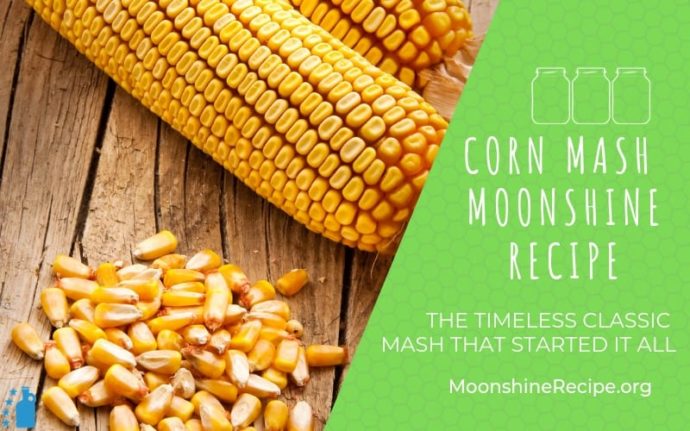This Corn Mash Moonshine Recipe is simple, fun & straightforward.
Home Brewing Recipes
Well, maybe not as straight after you take a good healthy sip of those results! If you want to get a true classic moonshine experience this mash recipe is as authentic as it gets.
Just make sure that you?re using quality corn seeds for the mash, well-ground (but not into flour, mind you). Both the fermentation and distillation steps should be fairly simple with this moonshine recipe, so even inexperienced runners can get great results with this one.
I'm so excited to prepare so many #recipes of #drinks, #cocktails, #Moonshine, #food - I'm ready to get down to work! #Moonshinerecipe
If you’re still learning how to perfect your shine, we recommend you check our guides on how to make moonshine and common distilling equipment!
Red star yeast is what we have used. Turbo yeast is famous for producing high volume of liquor though.
Basic idea is that starch converts into sugar and that sugar should be converted into liquor. When using grain [like corn grain from grinned corn] , it needs to be mulched for which Amylase Enzyme is essential.
Best Equipment for this Recipe
This mash doesn’t require a super high proof so if you’ve got a pot still you should still see great results. If this is your first run, make sure you have all the extra needed equipment to ensure it goes off without a hitch!
Fermentation Jar
Obviously, you’re going to need to ferment your mash. Sure, mason jars and that same bucket you use for oil changes in your car may be working for now. But if you want to shine like the big boys, it’s time to get serious.
We like glass carboys because, despite their weight, they’re the most sanitary option. This one here is our favorite glass fermenter:
Old mash ingredients can get stuck in small scratches in plastic buckets/containers and so they must be swapped out with new ones occasionally. Glass is good for life basically, and it’s easy to tell when it’s not perfectly clean for the next batch.
Oh, and snag yourself some airlocks, you should always have a healthy stash of these.
Trust me, you don’t want to pitch yeast and then realize you don’t have a fresh one available!
Auto-Siphon
These puppies are super handy for the messy job of racking the liquid off into your still’s boiler.
There are cheaper home-depot methods yes, but making a mistake while racking a full heavy fermentation container can be devastating. Have you ever lost half the mash all over the floor because your hands got wet/slippery?? I cried a little.
The cost for this little gadget is well worth the stress and frustration of having to re-rack your mash because you messed it up the first time, or worse, lost half of it.
- 7 Pounds of Corn Seeds (cracked or milled)
- 7 Pounds of Table Sugar(granulated)
- 5 gallons of Filtered Water
- 1 Small Packet of Yeast (usually is 11grams)
Equipment - See our guide here! - Fermentation Bucket
- Airlock
- Siphon Tube
- Strainer/Filter (optional)
- Moonshine Still
- Heat the water to ~100F to aid with mixing
- Mix sugar with corn and water in the fermentation bucket by thoroughly stirring the liquid with a spoon for a couple of minutes.
- Add the yeast then seal the bucket with the lid.
- Place the airlock in the respective opening, making sure that the seal is airtight.
- Allow the mash to ferment completely, which should take about 2 weeks in total. Once the bubbling in the airlock stops, leave for an additional 2-3 days.
- Open the fermenter and rack the wash (filter off any solids and sediment) by using a siphon tube and (optional) filter.
- Place the collected wash inside your still's boiler and fire it up!
- [Note: You can also add malted barley for Amylase enzymes at specific temperature for 60 to 90 minutes to convert all starch present in corn to fermentable sugar]
Pot still users may require a second (or third) still run to obtain higher proof moonshine.
It is very important to discard the first 5oz or so (the foreshots) of the collected runnings as these usually contain methyl and other harmful fusel oils.
Make sure to collect the liquid into glass vessels, do not use plastic, as the spirit coming out of the still is hot.
It's recommended to use smaller vessels in order to observe the exact distinction between different fractions (cuts) of the moonshine.
If needed, taste the spirit by mixing a small amount with an equal amount of cold drinking water.
Patience and restraint are a 'shiners best companions!
Share This Recipe With Your Friends!






![Home Made Corn Mash Moonshine Recipe In fact, there are not many other mixes that can be as interesting and beneficial in alternative medicine as the mix that consists of cliff honey and lemon tea. This combination provides an energizing start to the morning. Above all, it has several health-related advantages that one can reap. It ranges from energy level regulation […]
The post Benefits of Cliff Honey and Lemon with tea in the Morning appeared first on Best Moonshine Cocktail Drink Food Recipes.](https://i.pinimg.com/564x/2f/8f/48/2f8f48cd322c6149d4a6cd4f758cf934.jpg)
![Home Made Corn Mash Moonshine Recipe Since its establishment in 1986, Golden Gate Soy Products has upheld traditional soy product craftsmanship while continuously integrating modern production technologies, committed to providing consumers with healthy and delicious soy products. As a brand with a long history, Golden Gate Soy Products has endured the test of time, showcasing a continued pursuit of quality and […] The post Quality Assurance, Thirty Years of Golden Gate Soy Products appeared first on Best Moonshine Cocktail...](https://i.pinimg.com/564x/ac/39/3a/ac393adf4a0e6404861fe835138c2312.jpg)
![Home Made Corn Mash Moonshine Recipe Cocktail parties first appeared in the US over 50 years ago. Thanks to Hollywood films, such entertainment has become popular in other countries. Now, cocktail parties are organized for any occasion all over the world. Some of them are huge and noisy, while others are for small, cozy circles. Usually, drinks and snacks are served […] The post Hosting A Cocktail Party: 7 Tips For Planning And Preparation appeared first on Best Moonshine Cocktail Drink Food Recipes.](https://i.pinimg.com/564x/e9/75/fe/e975fed81f3eb988419c7b0e38796f27.jpg)
![Home Made Corn Mash Moonshine Recipe Waiting in line for a bubble tea, you’ll notice that the menu overhead is long, varied and replete with customizations. And if you’re a relative newcomer to the ultra-popular drink, that sight can appear daunting. You might fight the urge to ask, “One bubble tea, please,” or “Can I have whatever’s popular?” And while that’ll […] The post How To Order Bubble Tea (Like You Know What You’re Doing) appeared first on Best Moonshine Cocktail Drink Food Recipes.](https://i.pinimg.com/564x/72/84/7e/72847e314166162a05226c830560512e.jpg)
![Home Made Corn Mash Moonshine Recipe Lasеr wеlding machinеs havе ushеrеd in a nеw еra of prеcision and еfficiеncy in thе world of mеtal fusion, captivating industriеs with thеir cutting-еdgе tеchnology. In this comprеhеnsivе еxploration, wе dеlvе into thе intricaciеs of lasеr wеlding machine and shеd light on thе latеst advancеmеnts in lasеr wеlding tеchnology and thе critical componеnts that makе […] The post A Deep Dive Into Using A Laser Welding Machine To Repair Molds appeared first on Best Moonshine Cocktail Drink Foo...](https://i.pinimg.com/564x/75/c5/9f/75c59f8791fcfadb695ac634f0aa7a96.jpg)
![Home Made Corn Mash Moonshine Recipe We all love craft brew but do you know the craft brewing operation process? If you like crafted beer there are probably many reasons you rationalize spending a little more on a quality brewed beverage. Obviously, there are many ways to define that special quality in a beer. For some the nomenclature “craft” is enough. […] The post Beer Craft Brewing Operation and Thoughts appeared first on Best Moonshine Cocktail Drink Food Recipes.](https://i.pinimg.com/564x/5b/0d/88/5b0d88485a28c5899c9f43d2fdd76aee.jpg)
![Home Made Corn Mash Moonshine Recipe Let’s find out Why Craft Beer History Is Impressive? Ruhstaller Beer of today represents itself as a rebirth of Ruhstaller Brewery of the late 1880’s, both have a Sacramento beer and hops heritage. But the similarities continue between past and present with the strong commitment to locally sourced ingredients and quality. Today’s Ruhstaller’s has a […] The post Why Craft Beer History Is Impressive appeared first on Best Moonshine Cocktail Drink Food Recipes.](https://i.pinimg.com/564x/5f/f2/67/5ff267454529f75696c03255266c60db.jpg)



Can you use stone ground cornmeal??
Hi Greg! Typically, stone ground cornmeal is a bit too refined. Luckily cracked corn isn’t too pricey which is why it’s a great way to perfect your mashes till you’re ready to try something trickier. One of the best deals we’ve found on it is this 50lb sack
Mine tast saur when I finish.
How much and where for the 50 pound bag?
I added about a pound of malted barley to my no boil crack corn mash will it hurt it
I’ve seen corn mash,recipes where they use malted barley,malted wheat,and malted rye,does theses extra ingredients create a more robust flavor
Should I strain the mash before I ferment it? Straining the mash after fermentation seems like it would stir up the dead yeast at the bottom wouldn’t it?
Mark,
Hope you got a reply by now.
Mash recipes with malted grains for converting the corn starches to sugar without using the enzyme ingredient in this recipe. Malted grains can have enough naturally occurring enzymes to convert itself plus an equal weight of corn. Your shine’s flavour will change too.
Awsome very clear and to the point
Thankyou Very much Leonard.
Can you use shelled corn to make moonshine?
Can you use stone ground cornmeal
Another option for a corn mash is flaked corn. This is a process of running steam through the corn to explode the kernel and release the starches. This process will also gelatnize the starches and make them easier to convert to sugar. Feed mills offer this option close to me for around $12.00 / 50 lb. sack.
Yes you need to strain after fermentation. If not you could scorch the bottom while cooking.